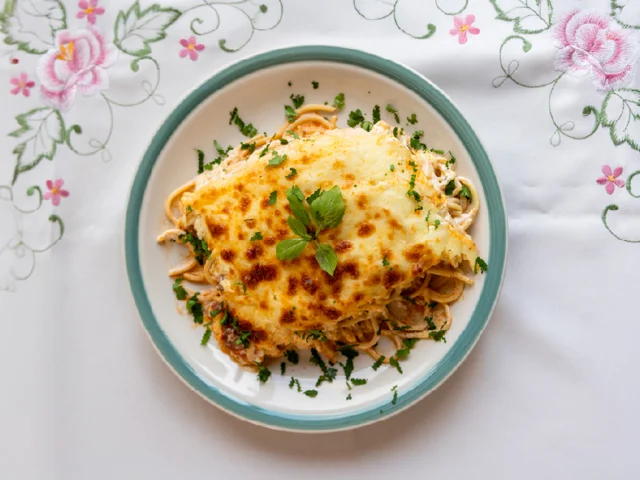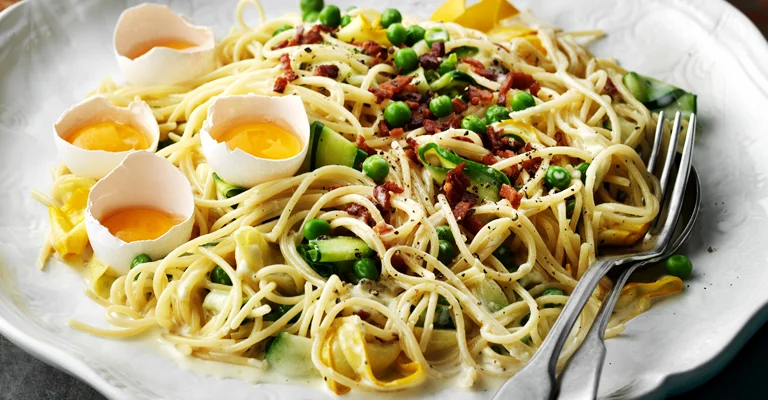


For fresh-tasting zucchini carbonara leftovers, seal them in a container and refrigerate for no more than 2 days. To reheat, warm the leftovers slowly in a pan over low heat, adding just enough water or milk to make the sauce creamy again. Avoid microwaving, as it can quickly cook the eggs too much and spoil the smooth texture of the sauce.
No, we do not recommend freezing the zucchini carbonara, as the texture of the sauce will change when frozen.
Yes, you can use fresh peas. Fresh peas tend to have a sweeter flavor and a crispier texture. To prepare fresh peas, blanch them briefly in boiling water for 2–3 minutes, then drain and add them to the pan with the zucchini towards the end of cooking.
We offer a few useful tips and tricks to help you make the best zucchini carbonara.
Adding a mix of zucchinis to your carbonara brings vibrant colors. For visual appeal, use a julienne peeler or a sharp knife to slice both yellow and green zucchinis into ribbon-like strands. These ribbons mix well with the spaghetti, providing a striking contrast of colors that is as delightful to look at as it is to taste.
When selecting zucchinis, make sure to pick the best quality to ensure the dish turns out both flavorful and appealing. The zucchinis should feel solid and firm to the touch; any softness or mushiness can indicate they are overripe or dehydrated. You want zucchinis with smooth, glossy surfaces without any nicks, cuts, or blemishes. The color should be a vibrant green, although some varieties may be slightly yellowish or pale green, which is fine as long as the skin looks unblemished.
Our zucchini carbonara is a fresh vegetable take on the classic carbonara. Fried zucchini strips join the spaghetti and are coated in a deliciously creamy sauce. We have added tasty green peas for extra color and texture.
Traditional carbonara, renowned for its simple yet flavorful ingredients, has been a favorite for decades. While our version introduces a fresher, greener take, we have made sure it stays true to its origins.
Frying the zucchini strips in butter and rapeseed oil gives them a delightful texture – slightly crisp on the outside yet tender inside. This step imparts a rich, nutty flavor to the dish, adding depth. The addition of frozen green peas introduces a burst of earthy sweetness and contributes to the visual appeal of the zucchini carbonara, giving it a fresh, green look. A simple squeeze of lemon juice adds a welcome touch of brightness, contrasting beautifully with the rich creaminess of the dish.
For more pasta dishes with vegetables, try our Spinach and Zucchini Lasagna with Béchamel Sauce or Homemade Beef Lasagna with Vegetables. We also have several vegetable carbonara variations, like the creamy mushroom carbonara and the easy vegetarian carbonara.
While a classic carbonara typically uses just eggs and cheese for the sauce, adding a little cooking cream can go a long way. The cooking cream melds with the cheese to form a soother, velvet sauce that richly coats the spaghetti and vegetables. Just before serving, we top each portion with an egg yolk and mix it into the warm pasta. The result is an extra luscious sauce that is both delightful and exciting to present to your guests.
If you like a meaty depth to your carbonara, try adding beef bacon. Its savory and salty flavor pair well with the rich sauce and sweet vegetables. Salmon is also a great choice, and you can use both smoked or fresh salmon for a rich and savory taste. For a simpler variation, switch out the pasta with another type. Tagliatelle remains a popular choice because of how well the creamy sauce adheres to the pasta.

Fall in love with pasta all over again, as you serve your loved ones creamy dishes made richer with Puck—and your special touch. Our inspiring recipes, general guidelines, and detailed articles will set you on the path to culinary creativity. With Puck’s entire range of cooking creams and sauces that meet your high standards, you’ll love putting your personal spin on pasta.